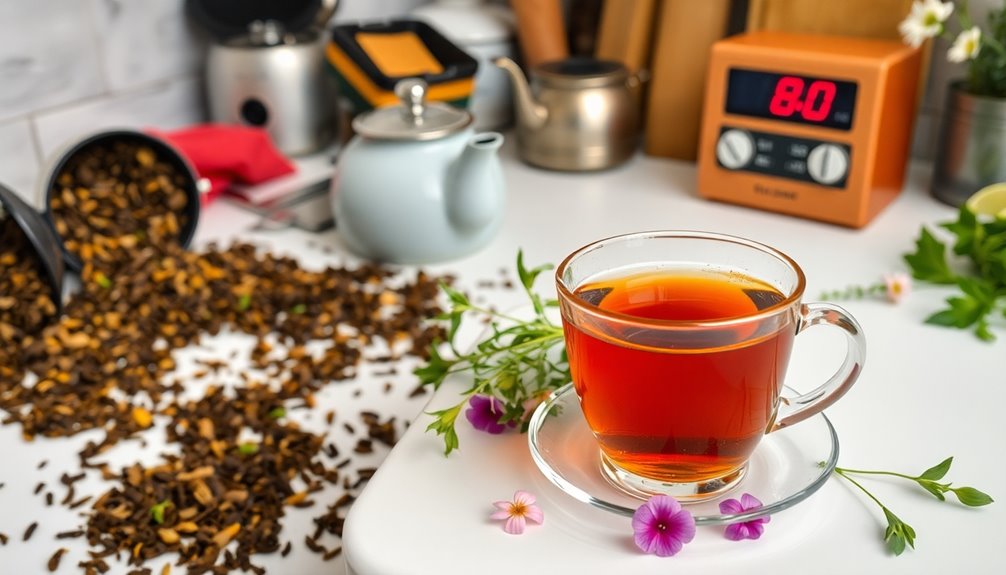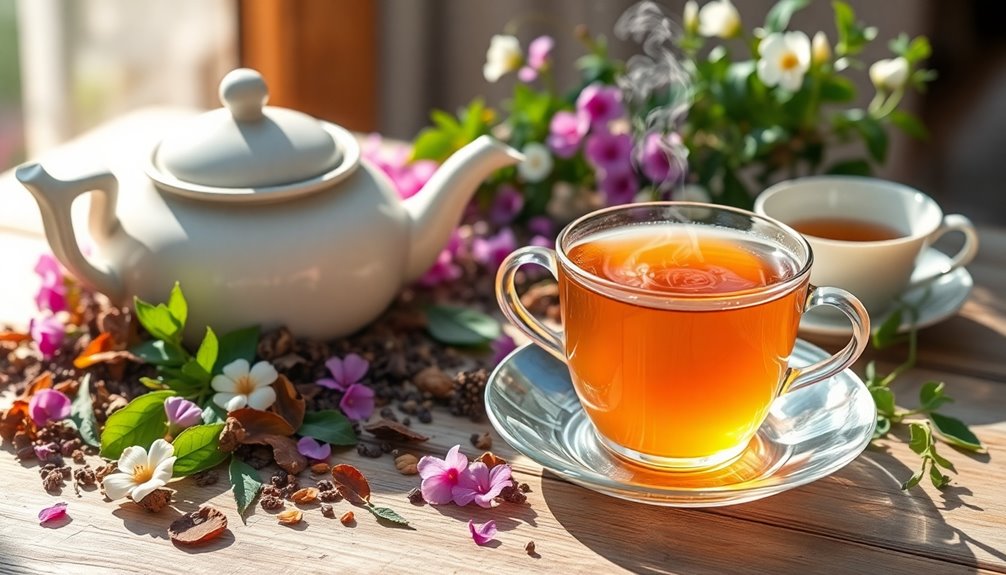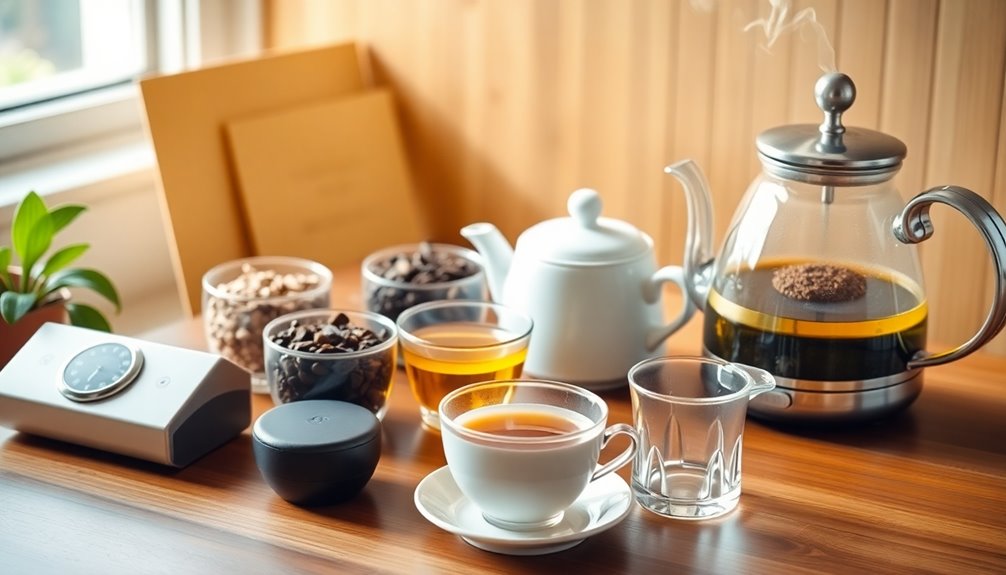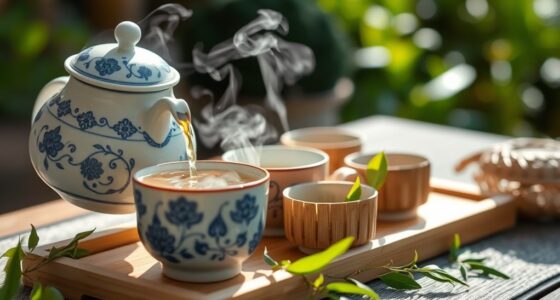When you cold brew tea, the cold water slowly extracts flavor compounds, tannins, and caffeine, leading to a smoother, less bitter taste. The low temperature prevents rapid release of harsh tannins and bitter components, preserving delicate floral and fruity notes. This gentle extraction creates a richer, more nuanced flavor. If you keep exploring, you’ll discover how different teas and steeping times further influence the subtle complexity of cold brew tea.
Key Takeaways
- Cold water extracts flavor compounds slowly, emphasizing delicate aromatic notes and reducing bitterness from tannins.
- Lower temperature limits the release of caffeine and tannins, resulting in a smoother, less astringent tea.
- Extended steeping (8-12 hours) allows full extraction of aromatic and flavor compounds, enhancing complexity.
- Cold brewing favors gentle, selective extraction, preserving natural sweetness and subtle floral or fruity notes.
- The gradual process minimizes harsh flavors associated with hot steeping, leading to a more balanced and mellow tea.
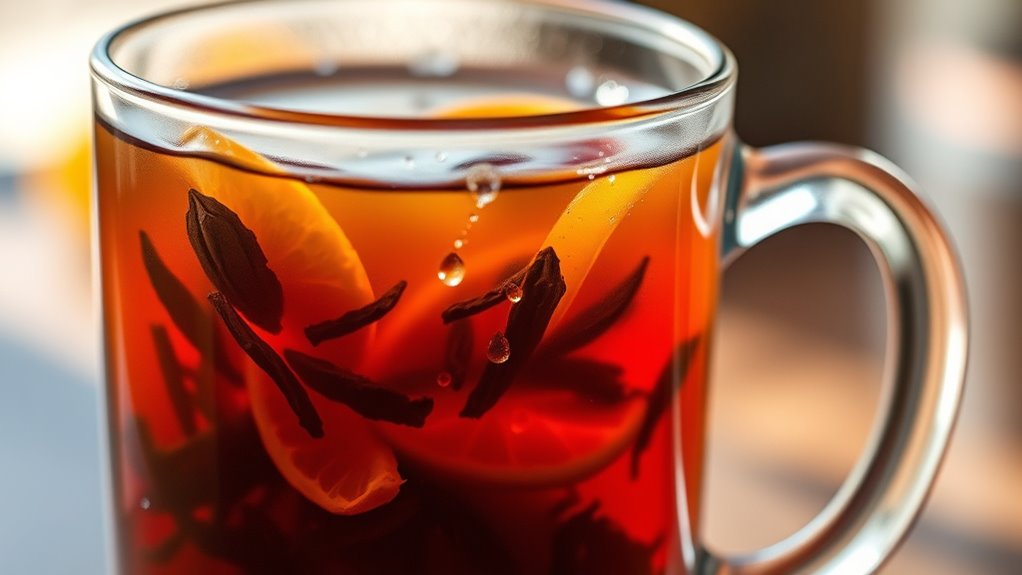
Have you ever wondered if there’s a cooler way to enjoy tea? Cold brew tea might just be your new go-to. Unlike traditional hot steeping, cold brewing involves immersing tea leaves in cold water for an extended period, usually several hours or overnight. This method changes the way tea releases its flavors, resulting in a smooth, subtly sweet beverage that’s perfect for hot days or anytime you crave something revitalizing. When you practice cold brew tea, you’re engaging in a different kind of tea steeping process—one that emphasizes slow, gentle flavor extraction without the harshness that sometimes accompanies hot brewing.
During tea steeping for cold brew, the temperature plays a vital role. Cold water extracts flavors more gradually and selectively from the tea leaves. This slower process means fewer bitter compounds and tannins are released, which often contribute to astringency in hot steeped teas. Instead, the flavor extraction becomes more nuanced, highlighting delicate notes like floral, fruity, or grassy undertones that might otherwise be overshadowed by bitterness. As a result, you get a tea that’s not only smoother but also richer in subtle flavors that linger on your palate.
Because cold brew tea relies on a gentle extraction process, it preserves more of the tea’s natural sweetness and aromatic qualities. When you submerge tea leaves in cold water, the extraction of caffeine and tannins is minimized, leading to a beverage that’s less bitter and more mellow. This makes cold brew an ideal choice for those with sensitive stomachs or anyone looking to reduce their caffeine intake without sacrificing flavor. Plus, since the steeping process takes longer—often 8 to 12 hours—you give the tea ample time to fully release its aroma compounds, resulting in a complex yet revitalizing flavor profile.
Another benefit of cold brew tea is the consistency it offers. Because the extraction is more controlled, you’re less likely to encounter the variability that hot steeping can produce due to fluctuating water temperatures. You can prepare your tea in advance and let it steep slowly in the fridge overnight, waking up to a perfectly crafted, smooth drink. This method also allows for experimentation: try different types of teas or adjust steeping times to discover your ideal flavor balance. Additionally, understanding the Vetted electric bike conversion kits can inspire you to explore other innovative ways to enhance your outdoor experiences, whether through tech or beverage preparation.
Frequently Asked Questions
How Does Temperature Affect Cold Brew Tea’S Chemical Composition?
Temperature effects play a key role in cold brew tea’s chemical stability. When you lower the temperature, it slows down the extraction of compounds like tannins and caffeine, leading to a smoother flavor. Cooler temperatures preserve delicate antioxidants and reduce bitterness. If you increase the temperature even slightly during brewing, you risk altering the chemical composition, which can affect taste and nutritional quality. So, maintaining a consistent cold temperature guarantees maximum chemical stability and flavor.
What Minerals Are Most Soluble in Cold Brew Tea?
Did you know that mineral solubility varies considerably during cold brew extraction? In cold brew tea, minerals like potassium, magnesium, and calcium are most soluble, contributing to its subtle flavor. Because cold extraction favors the solubility of these minerals, they remain in the tea, enhancing mineral content. This process results in a smoother, less bitter drink, with minerals staying intact, making cold brew tea both invigorating and nutritious.
How Does Steeping Time Influence Flavor and Chemical Extraction?
You’ll notice that steeping duration directly affects flavor development in your tea. As you extend steeping time, more compounds like tannins and polyphenols are extracted, intensifying bitterness and astringency. Shorter steeping preserves delicate flavors, while longer times deepen the taste. Adjust your steeping duration based on your preferred flavor profile, balancing extraction and complexity to achieve the perfect cup.
Can Cold Brew Tea Contain Harmful Compounds?
Imagine your cold brew tea as a quiet river, but sometimes hidden currents carry unwanted surprises. You might wonder if harmful compounds sneak in. While cold brew preserves tea antioxidants and keeps caffeine content gentle, prolonged steeping can release tannins or contaminants. To stay safe, stick to recommended steeping times, and enjoy your smooth, flavorful tea without worry. Your mindful brewing keeps the good in and the bad out.
What Are the Best Types of Tea for Cold Brewing?
You should choose tea varietals with gentle, nuanced flavor profiles for cold brewing, like white, green, or oolong teas. These teas tend to develop smooth, invigorating tastes without bitterness. Avoid strongly oxidized teas like black or herbal teas that may become overly bitter or lose their delicate flavors. By selecting the right tea varietals, you’ll enjoy a crisp, flavorful cold brew that highlights the subtle qualities of each type.
Conclusion
Now that you know the chemistry behind cold brew tea, you can appreciate its smooth flavor even more. With a little patience and the right technique, you’ll discover a refreshing beverage that’s worth the wait. Remember, good things come to those who wait, so don’t rush the process. Enjoy your perfectly brewed cold brew tea, sipping on a drink that’s as delightful as it is scientifically fascinating. Cheers to your tea journey!



